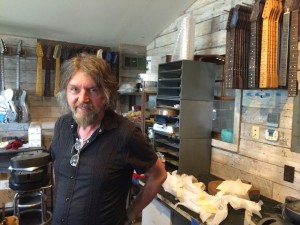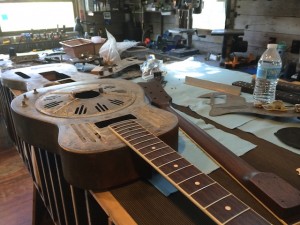
While in LA last weekend, I got to hang out with the guy who built my favorite modern guitar: the brilliant James Trussart.
I’ve been privileged to know many great luthiers over the years, but the thing that always impresses me about James is the way his instruments seem to be just one expression of a larger artistic sensibility. James grew up on a farm in rural France, but came to the States in the ’70s to play Cajun fiddle. He seems to have always been fascinated by vanishing Americana, be it an endangered folk music style, a faded and rotting road sign, or an ancient car rusting in a field. With their richly textured surfaces and variegated patinas, his metal-bodied guitars exude that same aesthetic. I’ve never known brand-new instruments to impart such a strong sense of the past.

A Trussart resophonic under construction.
James lives in a rambling old Arts and Crafts bungalow in LA’s Echo Park neighborhood, a place where every room possesses a rich texture of passing time. He’s surrounded by cool instruments — both his own and many lovely vintage guitars — and much beautiful metal work: doors, gates, plaques, and whatnot, all crafted by James. A detached building in back houses the workshop where James and his assistants build several hundred instruments per year.
One of James’s Steelcasters has been my favorite modern guitar for over a decade. (Here is a nice example of the guitar in action with Tracy Chapman, and here’s another example with the Eels.) Later I got in the habit of tuning the entire thing down a whole-step, with the lowest string dropped to C. I recorded the entire Mental 99 album in a day using this inspiring instrument. Thanks, James.
A highlight of this visit was James’s demo of his Percuphone — an electro-mechanical stringed instrument created in the ’70s by his friend Patrice Moullet. (Here’s a French-language Wikipedia article about the instrument, and here’s a YouTube video of a more recent model.) Check it out:
I always feel inspired after hanging out with James. And not just guitar inspiration, but an overarching desire to make, do, and surround myself with inspiring things. Merci beaucoup, mon ami. :beer:









How cool is that, you lucky git! It’s a great aesthetic if you can pull it off. I really like things that mimic that natural decay, but with enough of a twist that it shows its artificial. Like the black rust paint finish that National Resophonic offer on their Triolians. On the other hand I really don’t like relic’d guitars.
With the Trussart guitars do you notice anything that is markedly different from a wood body in the tone? I always wondered how effective JT’s technique was in halting any further progress of corrosion.
Well, the Trussart guitars LOOK like they should have a piercing, resonphonic sound. But my Steelcaster is markedly softer and sweeter-sounding than most Teles. There’s a hint of metallic resonance, but only a hint.
Interesting, I wonder if eddy currents in the steel surrounding the pickups are influencing the pickups enough to be audible. You would perhaps get a softer sweeter sound providing the eddy current effect was not too great. Too great an eddy current effect and you end up with low output and no treble. I haven’t got one to test but I suspect that the Bigsby Tele thick aluminium bridge mounts must really strangle Tele bridge pickups.
Does Trussart use a wood block either through the entire centre of the guitar or perhaps just under the bridge?
Used to have one of those Fender Aluminum Telecasters at my house for a couple years , was very pricey limited edition and hollow. Very nice guitar, I really liked it a lot. Think the guy still has it but he is no longer someone with whom I speak.Another guy I knew bought the Aluminum Strat it was pretty smoking too,very good sounding guitars.
This week on “Joe Has Cooler Friends Than You” . . . 😉
But seriously, that’s very cool. The Percuphone in particular fascinated me. I’ve not heard anything that sounds quite like it, although the lower string that James was manipulating by hand reminded me a little of Les Claypool’s Whamola (speaking of weird instruments). It must sound incredible through effects.
On the topic of metal guitars (and not the pointy, EMG-loaded type): have you played one of Electrical Guitar Company’s creations?
I love Trussart. A bit on the high priced side though. Re: metal body guitars, according to reading I found somewhere, 2/3 of a solidbody guitar’s influence on the sound (as opposed to the pickups’) is supposed to be in the neck, only 1/3 in the body. Explains why maple vs mahagony necks, or neck thicknesses, matter so much. And therefore, as long as the Trussarts have wooden necks they should retain quite some “wooden” signature. The acoustic resonators are a different case since there, the body also does amplification duty.
Thanks for weighting in, mbka. I don’t know whether the 2/3 vs. 1/3 formula is correct — I just don’t know enough! But man, it sure feels true. I always tell people the Steelcaster may look like it has a strong resophonic character, but really, it’s more like it has one resophonic grandparent — the predominant personality is warm and woody.
Hi Joe,
I found the link. It’s not a scientific paper but it’s a luthier’s assessment. Here:
Overview: https://www.frudua.com/guitar_craftpedia_en.html
Neck influence: https://www.frudua.com/neck_influence_in_guitar_tone.htm
And here is an actual scientific investigation of wood vs. pickup influence sin solidbody electric guitars:
https://www.calaverasfretworks.com/uploads/Pickups_and_Woods_in_Solid_Body_Electric_Guitars_-_Part1.pdf
https://www.calaverasfretworks.com/uploads/Pickups_and_Woods_in_Solid_Body_Electric_Guitars_-_Part2.pdf
Markus
When a guitar body and or neck resonates, it is taking energy out of the vibrating string faster. In an acoustic guitar, that energy can be converted to sound directly by the sound board. In an electric, it mostly decreases the pickup’s output at that frequency because the sound is coming from the pickup, not the body. We’ll ignore amp feedback for the time being.
That’s my Tuesday morning seat of the pants theory anyway.
Well in a way yes. But resonance also means energy storage. The energy of the string is taken up. In an acoustic, the soundboard converts it (as a transducer) into sound directly and the stored energy dissipates quickly. In an electric, the pickup is the transducer and takes away less energy from the string than the soundboard in an acoustic. So to begin with the electric should sustain longer than the acousitc. But the energy also goes into body and neck. It is stored there and slowly released, including, back to the strings. And that should generate additional sustain. The pickup will have somewhat less peak output but longer sustain on a resonant solidbody. (of course please someone correct me if I’m wrong).
Oh my…the Percuphone. Pretty sure I need one now.
Hi Pat! Of course — who among us does not need a Percuphone?
Joe , next time you`re in LA lets plugged your guitar and see what happen with the percuphone, recently i improved my playing with that Machine !! Hahah
Yes de chez oui !
Amazing James !
Cela me ressemble aux voyages dans les Alpes avec Catherine Ribeiro..
Mr Perckkkuphone, ça sonne toujours aussi bien! atemporel
Avec James , tu parler GUITARE…………